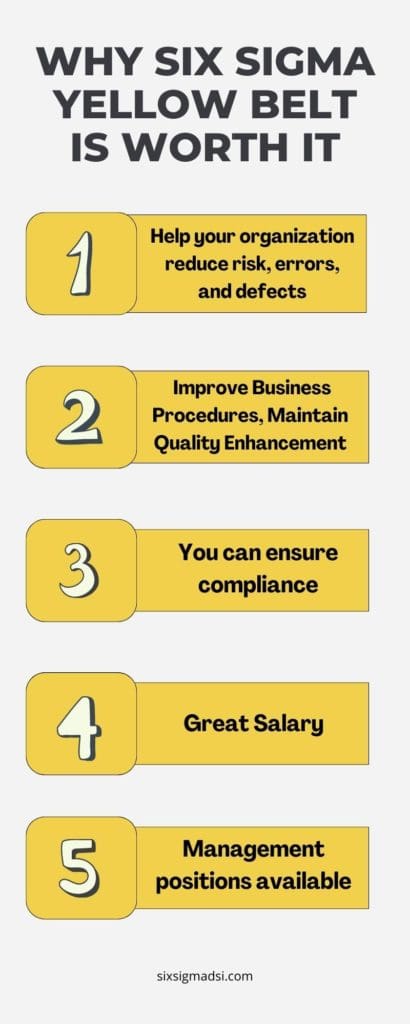Table of Contents
Is a Six Sigma Yellow Belt Worth It?
Certifications such as the Lean Six Sigma Yellow Belt course are needed to prove a business concept. IT professionals, however, are often driven to improve processes and streamline existing practices. What is the Lean Six Sigma Yellow Belt? What skills does it enhance and what career benefits do you get? Is being a certified Six Sigma Yellow Belt worthwhile?
This guide will help you understand the Six Sigma Yellow Belt basics and teach you the skills needed to become a Six Sigma Yellow Belt Certified Professional. Let’s get started!
A Review of Six Sigma Yellow Belt
The Lean Six Sigma Yellow Belt program can be a gateway to the field of process improvement for many people. It is well worth the Six Sigma Yellow Belt. This certification is particularly useful for team leaders and members who have to deal with local team-based problems. Much Yellow Belt-trained staff is often involved in improvement projects as part of a team that is supervised by Green Belt- or Black Belt-trained colleagues.
The Yellow Belts receive training in the fundamental tools and procedures necessary to be able to work in an improved environment. They also contribute to improvement efforts. Although you will need Black Belt-trained personnel, the work can’t be done without Yellow Belts.
Six Sigma Yellow Belt
Is it worth the effort to earn yellow belt certification? Yes! Yes! Entry-level staff who wish to improve the world, or executives who are champions of Six Sigma, can become yellow belts. The LSSYB certificate promotes Six Sigma tools, processes, and concepts.
Six Sigma is a method of continuous improvement that assists firms in reducing waste and eliminating non-value-added products. It focuses on the specific procedures that are part of larger initiatives. Employees can find inefficiencies and implement more efficient solutions across operations, saving organizations time and money. This ongoing development means that there is no end to the process. Processes can always be improved.
Lean Six Sigma Yellow Belt combines Six Sigma and Lean, two of the most important process improvement techniques. Toyota invented Lean. It uses the PDCA framework (Plan, Do, Check and Act) to optimize processes and results. To help in the continuous improvement of best practices, Toyota uses the “5S” process: Sort, Set in order, Shine Standardizes, Standardize and Sustain.
Motorola developed Six Sigma, which used the DMAIC method, Define, Measure Analyze and Improve, and Control. To improve results and minimize the chance of unintended errors, Six Sigma focuses on minimizing process variability. Although the acronyms and origins of these approaches may be different, they all aim to identify and fix problems and create a plan of attack and implement strategies that improve short- and long-term outcomes. Lean Six Sigma combines these two methods to offer a comprehensive project management outlook.
The Six Sigma Yellow Belt Outlook
Yellow belt jobs offer opportunities for those with an increased ability to spot process problems and suggest solutions.
Technical support manager These individuals are responsible for ensuring the efficiency and conformity of IT procedures and installations at a large scale.
Specialists in business process optimization can reduce time, labor, and resource costs, leading to increased productivity and profit. Business optimization specialists help project managers improve process efficiency and launch new initiatives by using their Yellow Belt training.
Supply Chain Manager – Supply chains are increasingly dependent on IT solutions to manage inventory logistics and track stock availability in real-time. Process efficiency is critical to ensure that businesses strike the right balance between spending money to open new stores and effectively using what they have. Lean Six Sigma experts are essential for creating a next-generation supply chain.

Is Lean Six Sigma Yellow Belt worth it?
What exactly is a Lean Six Sigma Yellow Belt? Lean Six Sigma takes inspiration from martial art training methods and categorizes its certifications according to their “belts”: White, Yellow Green, Black, Master Black, and Green. No prior knowledge of Six Sigma or Lean is required to become a Yellow Belt. Lean Six Sigma Yellow Belt courses train students to use both the DMAIC and PCDA methodologies in practice to gain the confidence required to assist project managers in reducing total waste. Six Sigma Yellow Belt is for IT professionals with experience who want to expand their career options and improve their ability to identify the root cause of process problems. The Six Sigma Yellow Belt introduces Lean and Six Sigma, while the Green, Black, and Master Black belts offer additional skills for project managers or C-level executives.
These are just a few reasons to be six-sigma yellow belt certified:
1. Help your organization reduce risk, errors, and defects
A Six Sigma Yellow Belt certification and Project Management Software like Celoxis are two of the key tools that enable a person to play an important role in an organization’s ability to identify and eliminate faults. The Six Sigma methodology allowed General Electric to save $350 million in 1998, and Motorola to save $17 billion in 2005. GE saved $1 billion in the second decade.
2. Improve Business Procedures, Maintain Quality Enhancement
You will be able to examine and optimize the manufacturing and business processes of a company after you have completed the six-sigma yellow certification. You will also be able to analyze current processes in detail and understand how they impact quality performance. Additionally, certification demonstrates your ability to achieve sustained quality improvement required by organizations. If a project is not on track, you can closely monitor it and take corrective steps to get it back on track.
3. Markets can help you increase your value
This is without doubt one of the greatest benefits of six sigma certifications. Six Sigma methods are used in many industries including telecom, banking and financial services, IT, human resource management, marketing, and aerospace. Six Sigma-certified people are skilled in many strategies that can be used to improve corporate operations, increase employee acceptance, decrease expenses, raise revenue, and all of this, regardless of industry.
4. You can ensure compliance
Accreditation as Yellow Six Sigma requires extremely high-quality standards. Many vendors, purchasers, oversight bodies, and other stakeholders use Six Sigma criteria when reviewing accounts or products. Six Sigma Yellow Belt-Certified professionals are able to help their company maintain profitable contracts and adhere internationally to standards.
5. Management positions available
You will be able to quantify and measure the financial benefits of Six Sigma projects once you have obtained Six Sigma certification. Financial management and risk assessment skills will be key skills for middle- and upper-level managers in senior management roles.
6. Great Salary
It is difficult to obtain a six-sigma yellow certification. It is difficult to pass exams. A lot of practice is required to move up from one level to the next. Six sigma-certified professionals will be well paid. Six of the most highly-paid professionals in the industry are sigma-certified professionals, who earn more than $107,000.

Six Sigma-Certified Professionals Offer Organizational Benefits
Are organizations worth the cost of being yellow belt six-sigma certified? Yes! These are just a few of the compelling reasons Six Sigma-certified professionals can be an asset to any organization and help to attract business forward.
1. Increased Productivity
Allen Medical used DMAIC methodology and lean technologies in order to increase the production of Arm boards, despite the lack of manufacturing space. Their new method saved them an average of 45 seconds per Arm board and increased production from 5.3 to just over 6 hours per hour.
2. Lower Expenses
Reduced defects mean less waste and lower production costs, which in turn means more revenue. It can be costly to produce a low-quality product. A product or service with a low-quality product can drastically reduce its cost. This is the true “price” of quality.
3. You can increase client confidence in your organization
Six Sigma implementation can simplify operations and improve client satisfaction. Citibank used the cross-functional process mapping approach (CFPM), to identify inefficient processes and eliminate them. This resulted in higher customer satisfaction.
4. Increase trust and confidence among stakeholders
Customers and stakeholders trust businesses whose staff have the right credentials. If any of your employees are Six Sigma-certified, quality will be their top priority. Quality drives a company to be more competitive and inspires partner and investor confidence.
5. Reduce turnover and training costs
DMAIC could be used to manage human resources, according to a STUDY-GATED ARTICLE. This article presents a case study about a multinational corporation that lost a lot of money each year due to its 35 percent staff turnover rate. They wanted to see a 25% drop in this number. They adopted six Sigma and discovered that there were many contributing factors to the problem. The most important of these were low pay and poor employment prospects. To rectify the situation they implemented new hiring procedures and training of new staff. The results were excellent: 10% less staff turnover and $1.1 million in savings.

About Six Sigma Development Solutions, Inc.
Six Sigma Development Solutions, Inc. offers onsite, public, and virtual Lean Six Sigma certification training. We are an Accredited Training Organization by the IASSC (International Association of Six Sigma Certification). We offer Lean Six Sigma Green Belt, Black Belt, and Yellow Belt, as well as LEAN certifications.
Book a Call and Let us know how we can help meet your training needs.



















